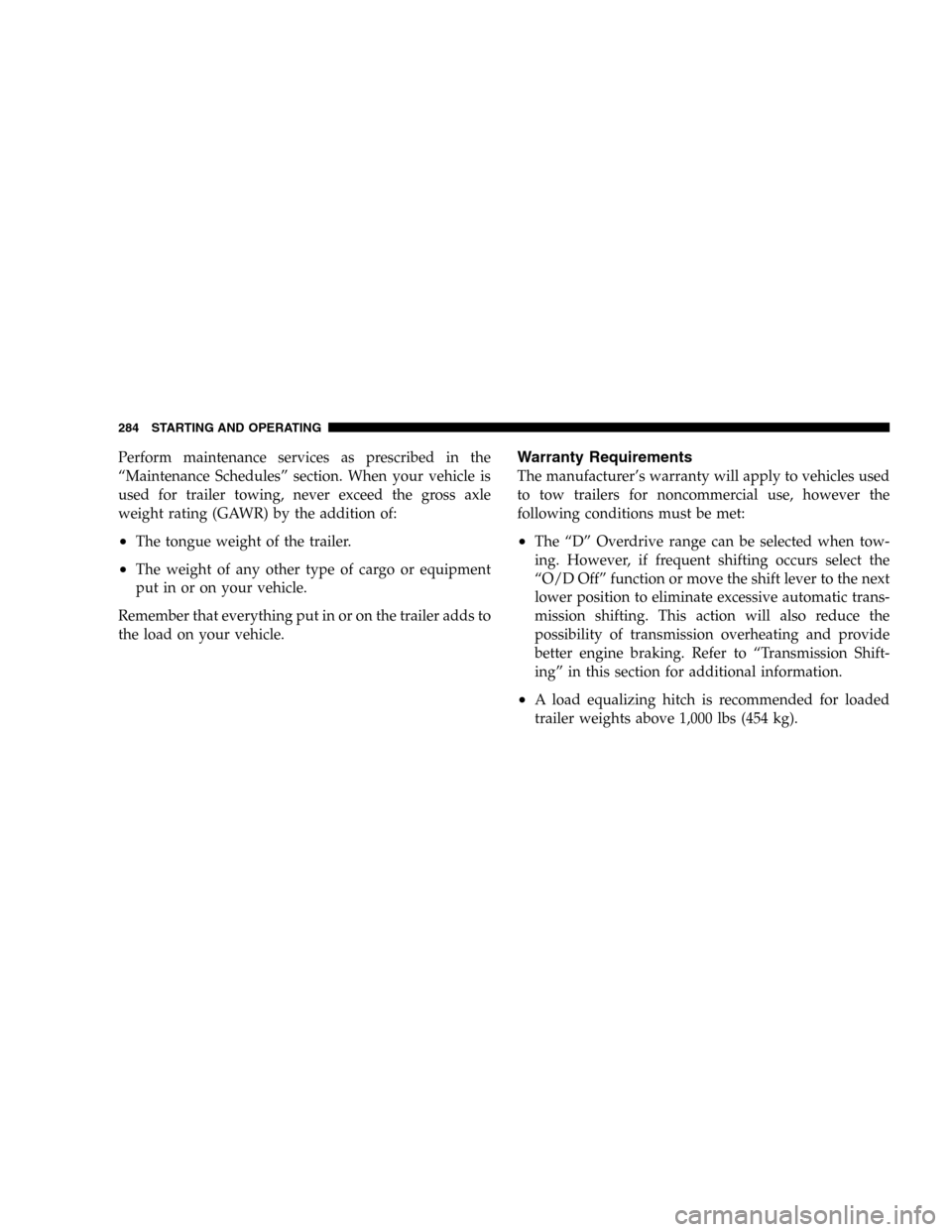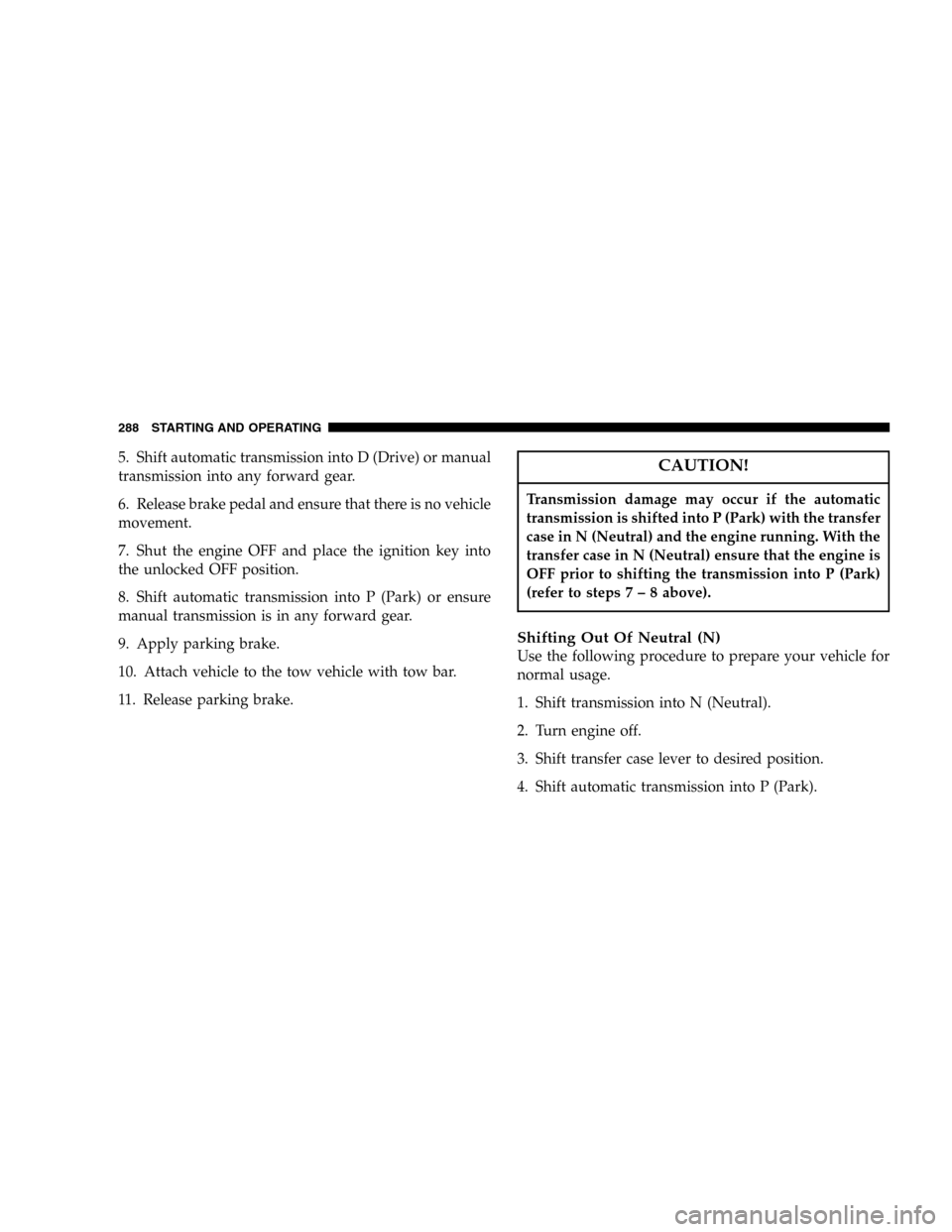Page 284 of 424

Perform maintenance services as prescribed in the
“Maintenance Schedules” section. When your vehicle is
used for trailer towing, never exceed the gross axle
weight rating (GAWR) by the addition of:
•The tongue weight of the trailer.
•The weight of any other type of cargo or equipment
put in or on your vehicle.
Remember that everything put in or on the trailer adds to
the load on your vehicle.
Warranty Requirements
The manufacturer’s warranty will apply to vehicles used
to tow trailers for noncommercial use, however the
following conditions must be met:
•The “D” Overdrive range can be selected when tow-
ing. However, if frequent shifting occurs select the
“O/D Off” function or move the shift lever to the next
lower position to eliminate excessive automatic trans-
mission shifting. This action will also reduce the
possibility of transmission overheating and provide
better engine braking. Refer to “Transmission Shift-
ing” in this section for additional information.
•A load equalizing hitch is recommended for loaded
trailer weights above 1,000 lbs (454 kg).
284 STARTING AND OPERATING
Page 285 of 424
CAUTION!
If the trailer weighs more than 1,000 lbs (454 kg)
loaded, it should have its own brakes and they
should be of adequate capacity. Failure to do this
could lead to accelerated brake lining wear, higher
brake pedal effort, and longer stopping distances.
WARNING!
Connecting trailer brakes to your vehicle’s hydraulic
brake lines can overload your brake system and
cause it to fail. You might not have brakes when you
need them and could have an accident.
•Whenever you pull a trailer, regardless of the trailer
size, stop lights and turn signals on the trailer are
mandatory for motoring safety.
•Follow the maintenance intervals in schedule “B” for
changing the automatic transmission fluid and filter, if
you REGULARLY tow a trailer for more than 45
minutes of continuous operation.
STARTING AND OPERATING 285
5
Page 286 of 424
Minimum Vehicle Requirements for Trailer Towing
286 STARTING AND OPERATING
Page 287 of 424
RECREATIONAL TOWING (BEHIND
MOTORHOME, ETC.)
Towing – 2WD Models
Recreational towing is not allowed.Towing with the
rear wheels on the ground can result in severe transmis-
sion damage.
Towing — 4WD Models
CAUTION!
Internal damage to the transfer case will occur if a
front or rear wheel lift is used when recreational
towing.
NOTE:The transfer case must be shifted into N (Neu-
tral), and the transmission must be shifted into P (Park)(for automatic transmission) or into any forward gear (for
manual transmission) for recreational towing.
Shifting Into Neutral (N)
Use the following procedure to prepare your vehicle for
recreational towing.
CAUTION!
It is necessary to follow these steps to be certain that
the transfer case is fully in N (Neutral) before
recreational towing to prevent damage to internal
parts.
1. Depress brake pedal.
2. Shift transmission into N (Neutral).
3. Shift transfer case lever into N (Neutral).
4. Start engine.
STARTING AND OPERATING 287
5
Page 288 of 424

5. Shift automatic transmission into D (Drive) or manual
transmission into any forward gear.
6. Release brake pedal and ensure that there is no vehicle
movement.
7. Shut the engine OFF and place the ignition key into
the unlocked OFF position.
8. Shift automatic transmission into P (Park) or ensure
manual transmission is in any forward gear.
9. Apply parking brake.
10. Attach vehicle to the tow vehicle with tow bar.
11. Release parking brake.CAUTION!
Transmission damage may occur if the automatic
transmission is shifted into P (Park) with the transfer
case in N (Neutral) and the engine running. With the
transfer case in N (Neutral) ensure that the engine is
OFF prior to shifting the transmission into P (Park)
(refer to steps7 – 8 above).
Shifting Out Of Neutral (N)
Use the following procedure to prepare your vehicle for
normal usage.
1. Shift transmission into N (Neutral).
2. Turn engine off.
3. Shift transfer case lever to desired position.
4. Shift automatic transmission into P (Park).
288 STARTING AND OPERATING
Page 289 of 424
5. Start engine.
6. Shift automatic transmission into D (Drive) or manual
transmission into any forward gear.
WARNING!
You or others could be injured if you leave the
vehicle unattended with the transfer case in the N
(Neutral) position without first fully engaging the
parking brake. The transfer case N (Neutral) position
disengages both the front and rear driveshafts from
the powertrain and will allow the vehicle to move
regardless of the transmission position. The parking
brake should always be applied when the driver is
not in the vehicle.
CAUTION!
Do not use a bumper mounted clamp-on tow bar on
your vehicle. The bumper face bar will be damaged.
SNOW PLOW
Snow plows, winches, and other aftermarket equipment
shouldnotbe added to the front end of your vehicle. The
airbag crash sensors may be affected by the change in the
front end structure. The airbags could deploy unexpect-
edly or could fail to deploy during a collision.
STARTING AND OPERATING 289
5
Page 291 of 424
WHAT TO DO IN EMERGENCIES
CONTENTS
�Hazard Warning Flashers.................292
�If Your Engine Overheats.................293
�Jacking And Tire Changing................294
▫Jack Location........................295
▫Spare Tire Stowage....................295
▫Preparations For Jacking................296▫Jacking Instructions....................296
�Jump Starting Procedure..................299
�Emergency Tow Hooks — If Equipped........301
�Towing A Disabled Vehicle................302
▫2WD Models Only....................302
▫4WD Models Only....................302
6
Page 295 of 424
Jack Location
The scissor-type jack, and tire changing tools are stored
beneath the right rear seat. To remove the jack from its
stowage position, turn the thumb screw counterclock-
wise to loosen jack assembly and then remove it.
Spare Tire Stowage
To remove the spare tire from the carrier, remove the tire
cover, if equipped, and remove the lug nuts with the lug
wrench turning them counterclockwise.
Jack Storage Location
Spare Tire Mounting
WHAT TO DO IN EMERGENCIES 295
6